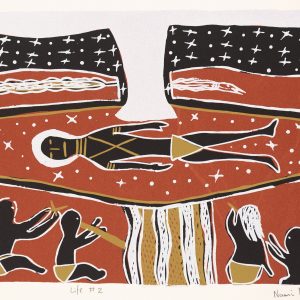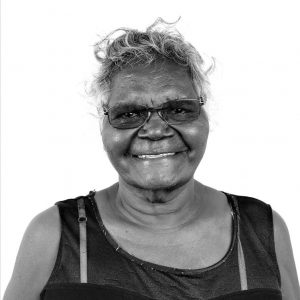Description
About the artwork: Rajarra & Wulakarra – Barramundi & Conical Fish Trap
the images depicted in this print by senior artist belong to country that lies near the outstation known as Gochan Jiny-jirra. Here lies a network of creeks and billabongs that during the dry season are a rich hunting area, especially for barramundi. The fish are caught in large numbers in fish traps woven from Pandanus or sedge grass. The barramundi are also hunted with spears and lures in billabongs and streams where they shelter from the heat of the sun under fallen logs. this lithograph depicts a ‘rajarra’ barramundi together with a conical fish trap.
Text provided by Maningrida Arts & Culture
One of three prints England Bangala created in 1999.
Details
- Limited edition etching on paper
- Edition: 50
- Editioned: August, 1999
- Size: 45 x 61 cm (image), 56 x 76 cm (paper)
- Paper: BFK Rives
- Printer & Studio: Jo Diggens, Northern Editions Darwin, NT
About the artist: England Bangala (Banggala)
England Bangala was born circa 1925 in central Arnhem Land and passed away in 2001. His traditional lands are in Central Arnhem Land and for many years he was a member of Maningrida Arts and Culture. In his later years he spent time with family in Gunbalanya (Oenpelli) in West Arnhem Land and painted for Injalak Arts. In Maningrida England painted exclusively on bark, however, in Gunbalanya he often used Arches Aquarelle watercolour paper.
His prints and paintings reflected the high status which he held in the traditional ceremonies of his community.
His pictorial style combines elements of the west and central Arnhem Land traditions. The organic forms he represents in his work often depict the elements of Gunardba women travelling across the land, creating sacred sites, law and language for the Gunardba people. These elements now reside in spirit form at sites specific to the An-ngulin clan.
A strong vigorous flow is characterised in Banggala’s work with its graphic boldness. The cross hatching is found within the figures and the schematic motifs of his work rather than in the background, as is more common to the art of Arnhem Land. The broad areas of colour, dotted subdivisions and plain background reflect Banggala’s association with the Rembarrnga language/tribal people. Rembarrnga art is not easily classifiable because most artists of this group paint in distinctly individual and different ways. The most likely reason for this divergence is geographical. The Rembarrnga speaking people belong to land over a vast area of south-western and south-central Arnhem Land, some of it inaccessible and therefore isolated. This has caused each small group to develop their particular traditions somewhat differently. The art of the group as a whole shares common themes of water and stone country and spirit figures.
During his life England was included in more than 40 group and solo exhibitions within Australia and overseas including in Canada, Denmark and the Netherlands. His artworks have been reproduced and referenced in numerous publications.
Provenance: This edition was created in partnership with Maningrida Arts & Culture and commissioned by Anne Phelan and John Clark of Framed Gallery, the premier and groundbreaking fine art and craft gallery that operated in Darwin from 1984-2017. The artist was paid at the time of printing.
This artwork was distributed by the Australian Art Print Network.







